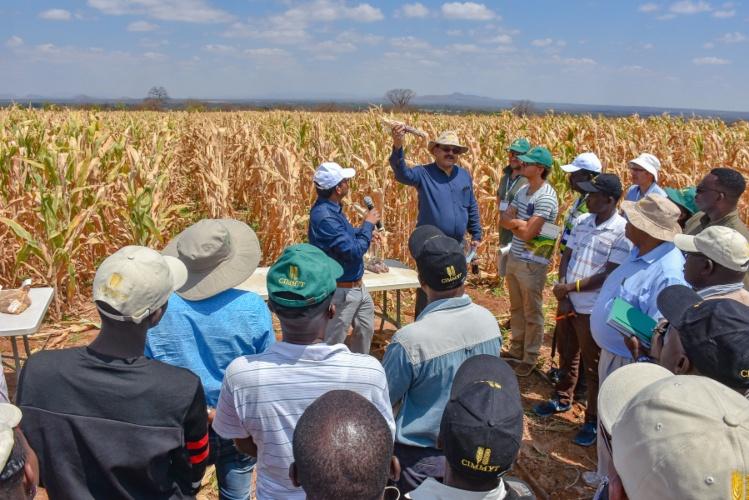A hype surrounds the proliferation of digital solutions to boost efficiency and productivity in Kenya’s agriculture. But what has been the reality on the ground? Tracing the expansion of Nairobi’s Silicon Savannah into the country’s rural regions, LSE Fellow Gianluca Iazzolino highlights the factors that have shaped the trajectory of the first generation of Kenyan agritech.
This is the first of four posts presenting key insights from the research project ‘A Tale of Two Green Valleys’ at the LSE Firoz Lalji Centre for Africa, which examines data-driven agro-innovation in California’s Central Valley and Kenya’s Rift Valley.
‘Not another app, please!’
Gesticulating with a feature phone in his hand, Ronald sits on a bench in the shadow of an acacia tree. He’s chairing a meeting for his avocado producer group in Muranga county, central Kenya, once one of the country’s key coffee-producing areas but which today caters to avocado-craving hipsters all over the world.
Our team have travelled here to understand how digital technologies and big data are changing the way food and agricultural knowledge and value are produced, as part of our ESRC-funded project A Tale of Two Green Valleys. According to the foreign and local tech-entrepreneurs that we met in Nairobi, Muranga county farmers bask in the glow of Nairobi’s Silicon Savannah – the constellation of start-ups, tech hubs and regional headquarters of foreign tech corporations and philanthropic foundations that have grown over the past decade thanks to investments in connectivity infrastructures and venture capital. And yet, here in Muranga, smallholder farmers like Ronald feel this glow may be a distraction. When asked what type of services he and fellow farmers most needed, he had a clear idea. ‘We don’t need another app’, he says. ‘Crates! We need crates to avoid our avocados getting smashed on the way to the buyer.’
Muranga is only a two-hour car ride from Nairobi, but the distance between Silicon Savannah’s agritech firms and the farmers who make up their customer base is much larger. The hype that surrounds the proliferation of digital solutions is steeped in expectations of greater efficiency and productivity. Smallholders like Ronald are indeed using digital technologies to better coordinate or reach out to customers, but in ways that tech entrepreneurs, policymakers and donors are not yet grasping.

Agriculture has been central to Kenyan politics and the economy since independence in 1963. Is this time different? Despite some continuity with past state-led initiatives to plan agricultural production and support farmers (as we’ll explain in more detail in a forthcoming paper), the Kenyan agritech scene that has emerged in earnest in the early 2010s features characteristics that break with previous eras of agricultural policymaking. New actors, including donors and tech firms, have appeared on stage, advancing discourses and approaches based on a digital solutionist ideology exported to Kenya directly from California’s Silicon Valley. Moreover, unlike in the past, when state and international donors prioritised cash crop producers, this time around most initiatives are targeting both agribusinesses and small-scale farmers.
Although the term ‘Silicon Savannah’ first surfaced online in 2011, according to Google Trends, the business and media interest in Nairobi’s digital ecosystem had been brewing since 2007. Two innovations, in particular, captured the interest of local and foreign innovators at this time: the crowdsourcing application Ushahidi, rolled out by community activists to monitor political violence in the aftermath of Kenya’s contested 2007 elections; and the mobile money platform M-Pesa, launched by Safaricom, the Kenyan associate of Vodafone UK, which became first a critical digital payment infrastructure for both individual and business payment and later a payment gateway for government services.
We don’t need another app ... Crates! We need crates!
Agriculture worker, during field research in Kenya.
The emerging tech scene in Nairobi helped attract both Kenyan and foreign entrepreneurs and graduates. For the latter, Kenya was perceived as having lower entry barriers in comparison with the saturated environment of California’s Silicon Valley. As one American tech entrepreneur described, foreign entrepreneurs ‘could raise capital more easily than in San Francisco to establish a start-up, afford to fail, and proudly add the failure on their CVs’. Entrepreneurs could apply for grants offered by development agencies, but they could also access new Social Impact Investments, which had been established by private equity firms after the 2008 financial crisis and which sought to recast investment in emerging markets as social investments. Around 2007-8, no profit foundations and equity funds similarly started injecting seed capital into start-ups through business incubators like iHub and MLab, and accelerator programs like GrowthAfrica, Pangea and TUMI. Nairobi became host to a myriad of entrepreneurship training programs and start-up competitions such as Apps4Africa and PivotEast. Entrepreneurship competitions such as Apps4Africa and PivotEast produced start-ups like I-cow and M-farm, which pioneered digital services for farmers in the early days of Silicon Savannah.
The backdrop of this ‘innovation landscape’ was shaped by both policymakers and donors. The Kenyan Government under President Mwai Kibaki had put to the top of its agenda initiatives to attract foreign capital through its Strategy to Revitalize Agriculture (SRA). Corporate-philanthropic organisations like the Bill and Melinda Gates Foundation and the Syngenta Foundation provided the necessary funding for initiatives financing and fostering the entrepreneurial skills of smallholder farmers. Kenya, already a laboratory for financial inclusion thanks to the popularity of M-Pesa, thus started emerging as a testing ground for technology applied to agriculture.
Three factors during this period fuelled the interest of local and foreign firms: the improvement of connectivity in rural areas as a result of falling costs of digital technologies; the availability of donors’ funding to explore the potential of Big Data as a strategic resource to reconcile productivity and sustainability in farming and food systems; and the rise of social impact investing (SII), defined by the Global Impact Investing Network (GIIN) as investments made into ‘companies, organizations and funds to generate a measurable, beneficial social or environmental impact alongside a financial return’.
By the admission of the same stakeholders (tech firms, philanthropic foundations, agricultural organisations, state agencies), the field, on the supply side, is more and more crowded. There is a genuine belief in the transformative potential of digital innovation for agriculture, with positive repercussions for both households’ welfare and national growth. This belief has translated into a substantial engagement, in terms of financial and human capital devoted to exploring paths for data-driven agricultural development. Most initiatives designed to better connect producers and buyers and improve agricultural efficiency, however, have so far struggled to scale up and we’re thus witnessing a thorough rethinking of the initial approach (which we will explore in the next blogpost in the series).
But, despite the picture still being blurred, an element of discontinuity with the past stands out: many of our interviewees pointed towards large numbers of Kenyan graduates starting to look at agriculture with different eyes. As a young Kenyan graduate pointed out to us, ‘In the past, parents used to tell their kids, “If you don’t study, you will become a farmer” because agriculture was associated with backwardness and failure. But now it’s different: farming requires digital skills and, if properly done, it can be rewarding and profitable’.
Farmers like Ronald, however, would object to the claim that farmers need digital skills above everything else. ‘We need fair prices, and intermediaries we can trust, and being able to take our avocados to the market’, he says. ‘And crates. We need crates’.
Read the full series based on research findings from the project A Tale of Two Valleys.
Photo by Surface on Unsplash





